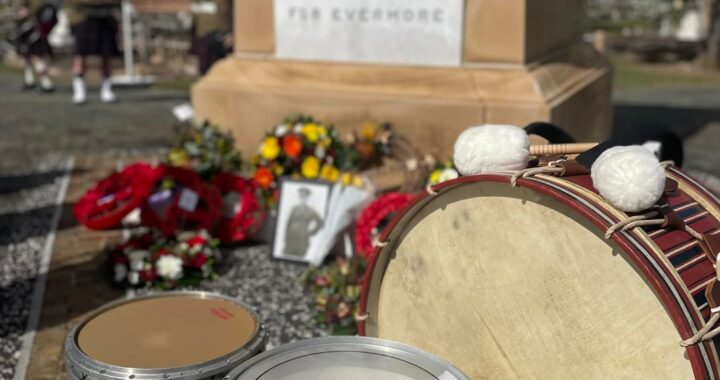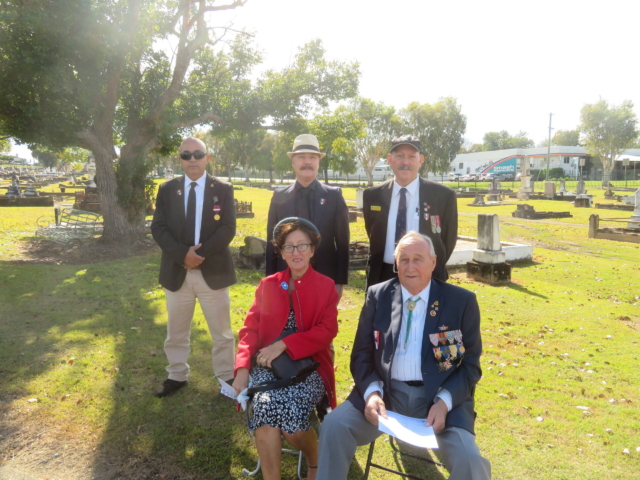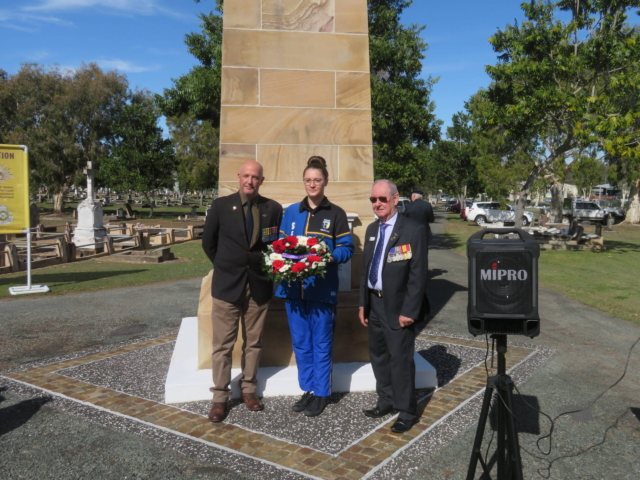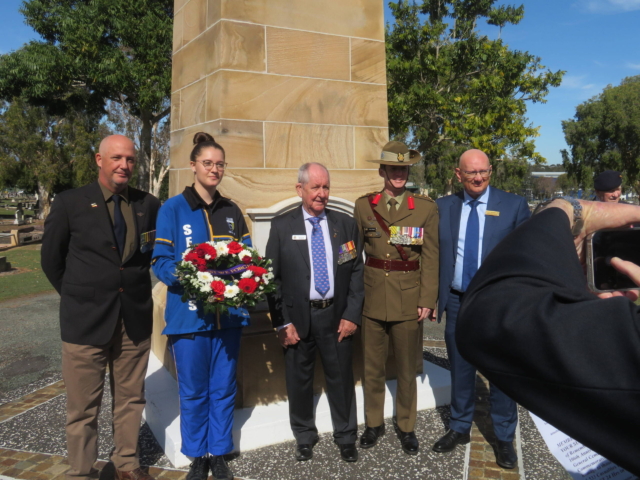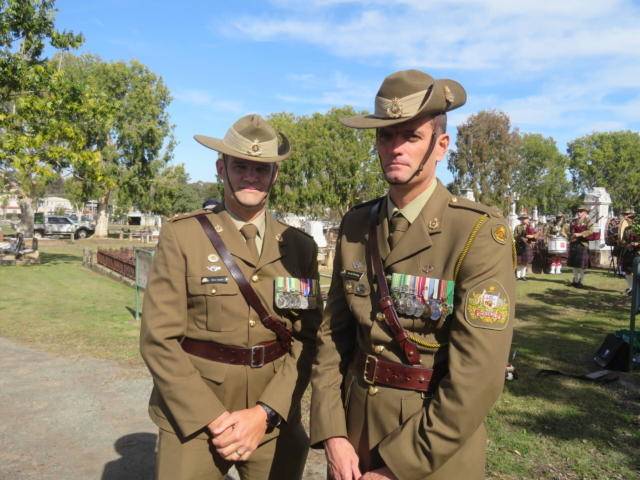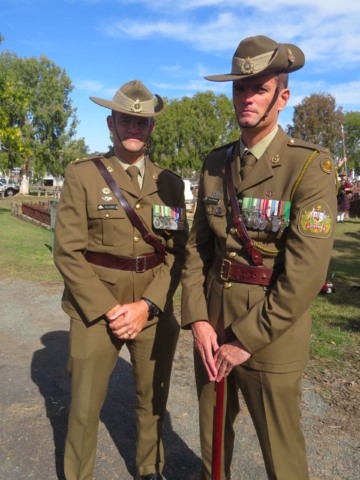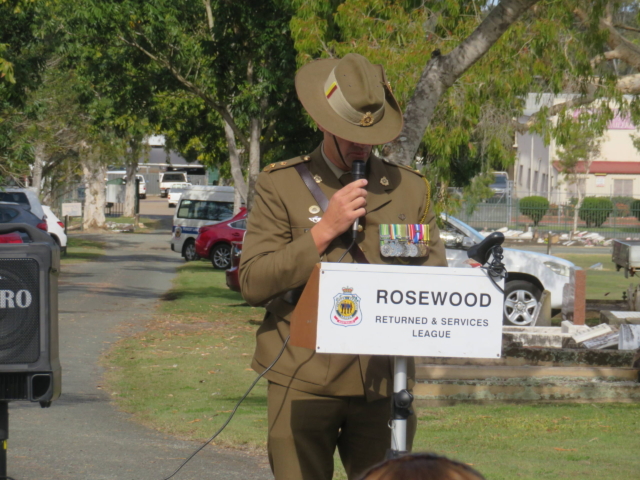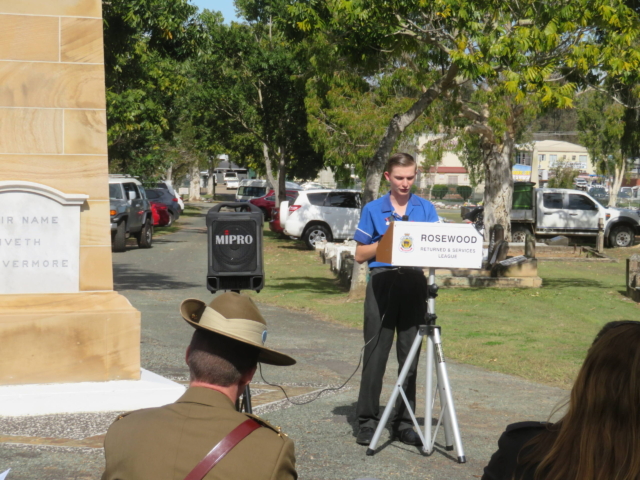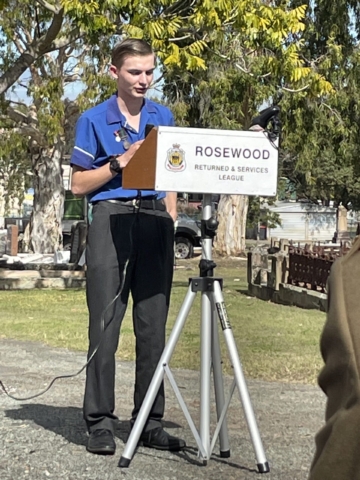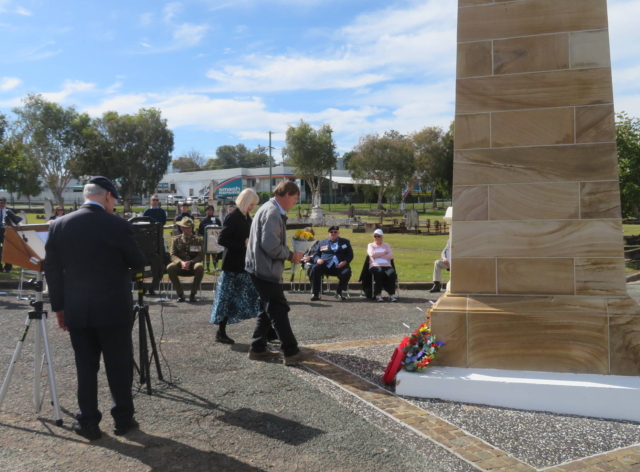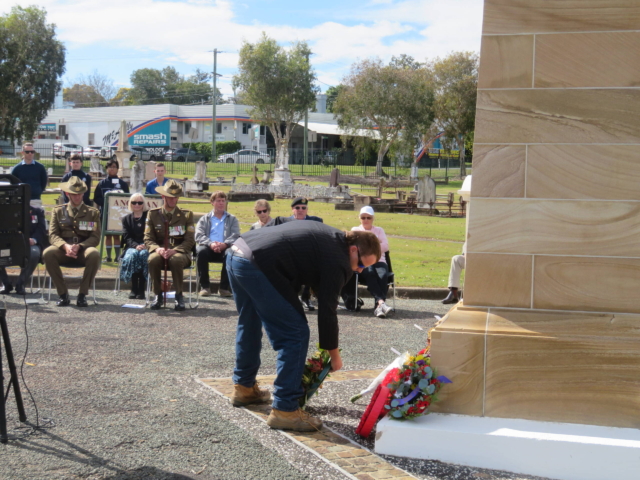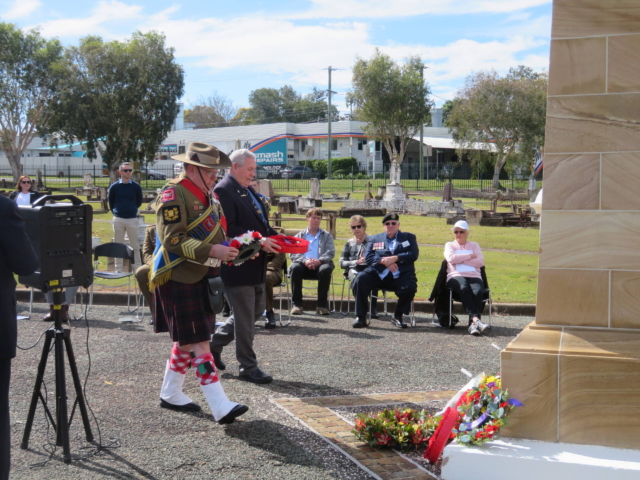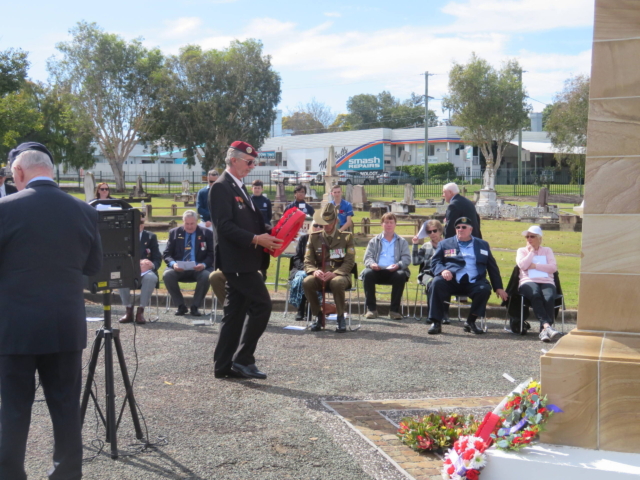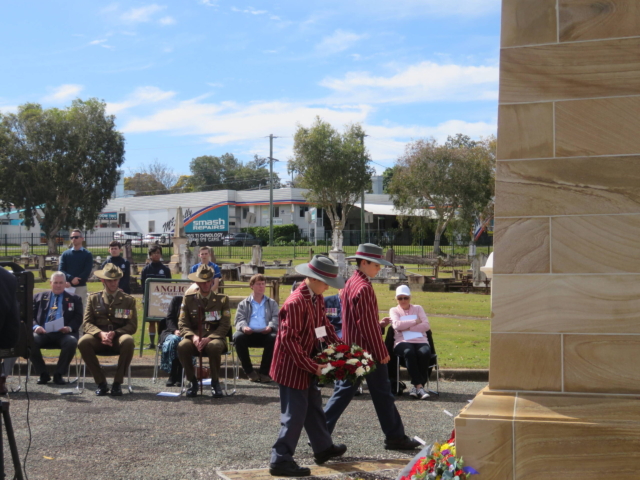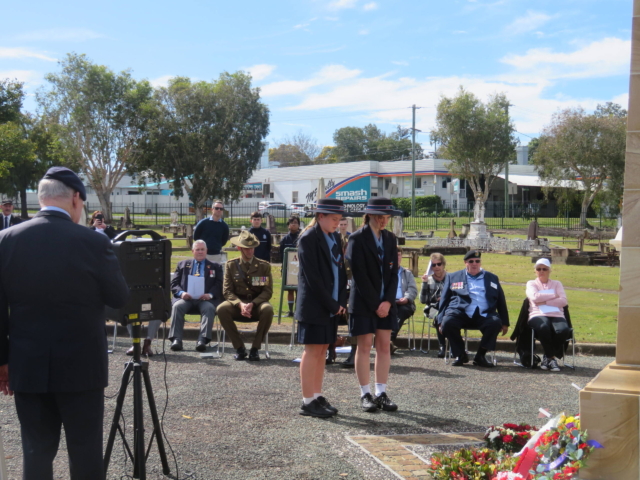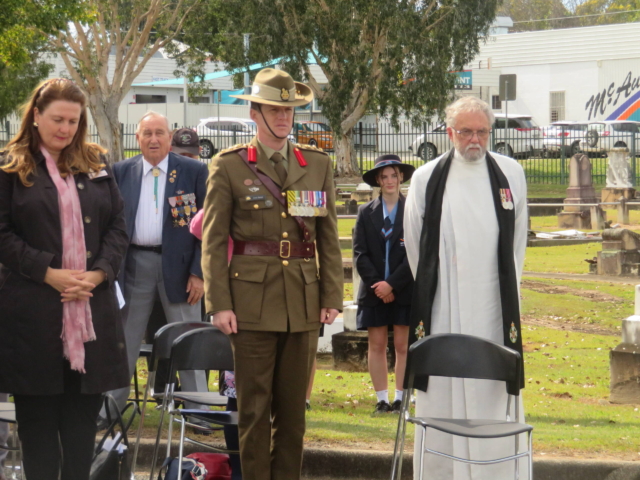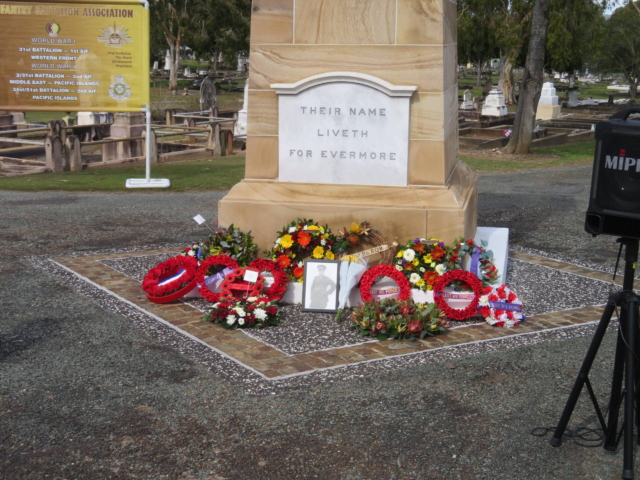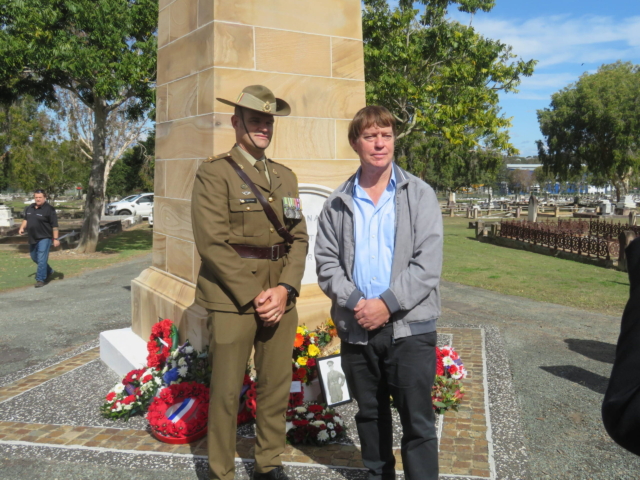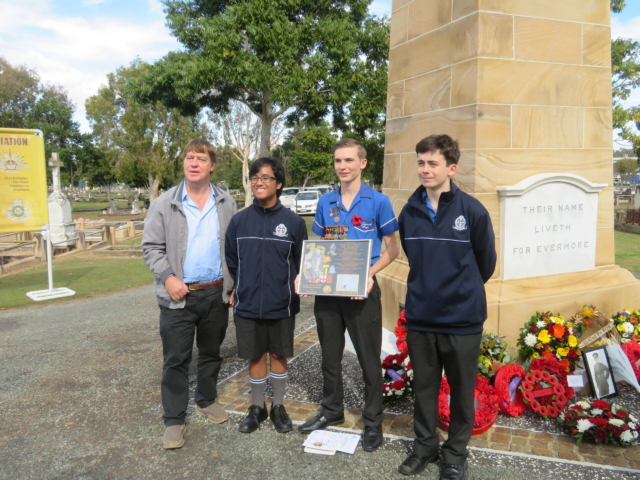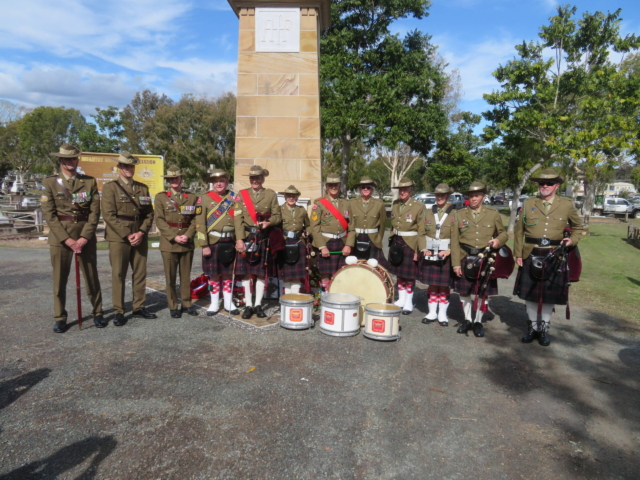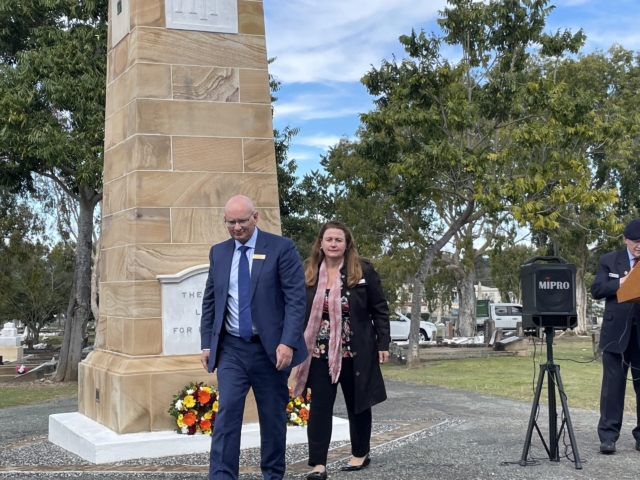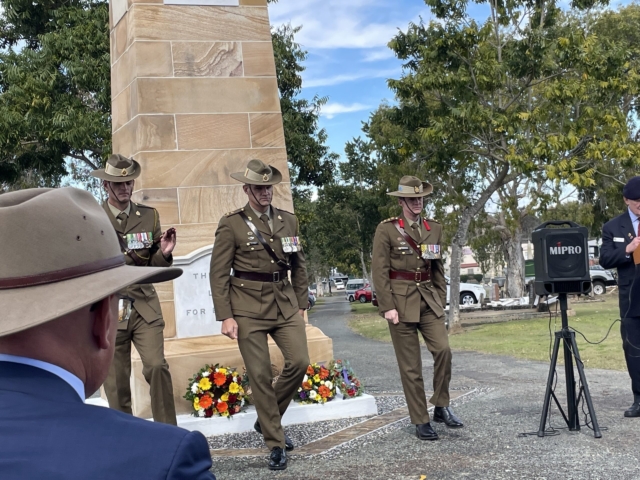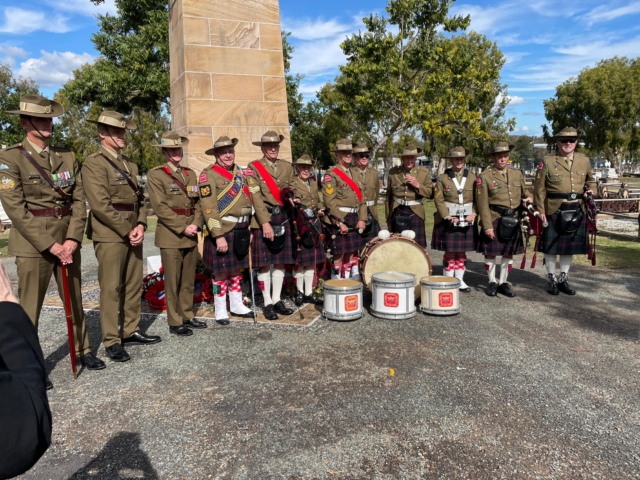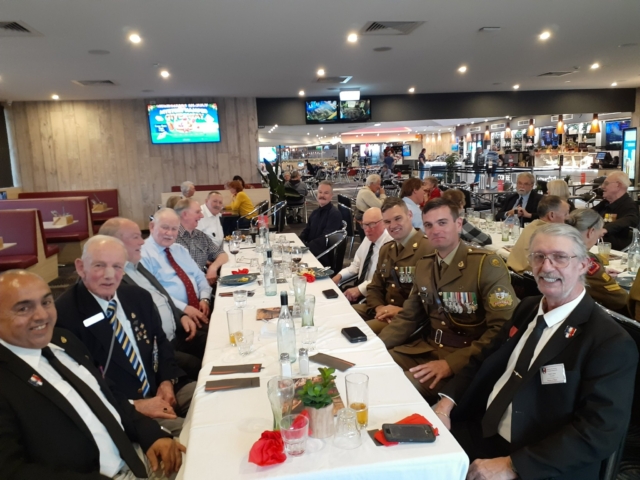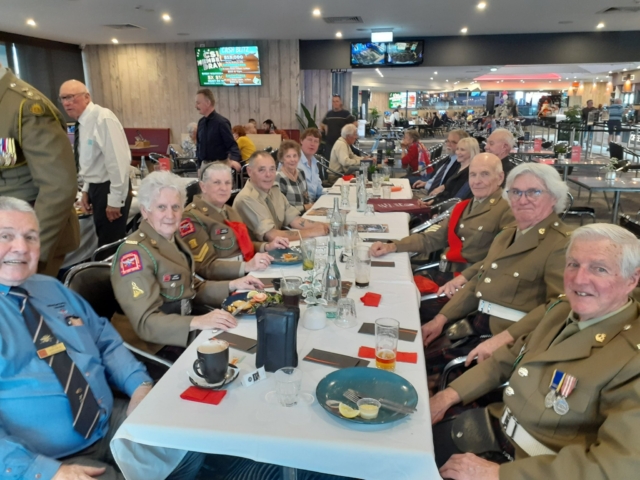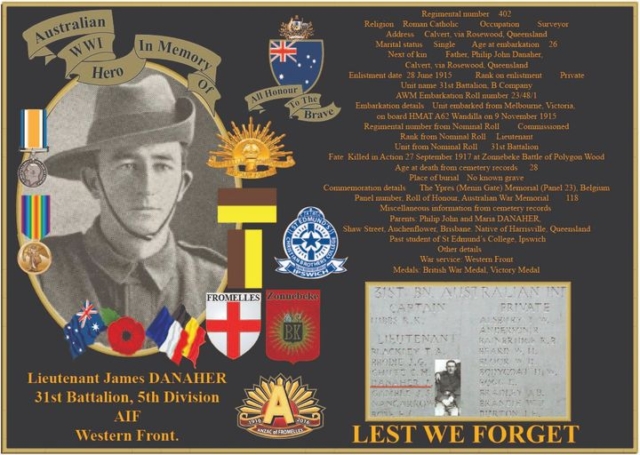On Tuesday 19th July 2022 members of the 31st Infantry Battalion Assoc (Brisbane Branch) in conjunction with the Ipswich & Rosewood RSL sub branches conducted a successful Commemoration of the Battle of Fromelles on the 106th Anniversary of the Battle.
–
In his welcome address, President Ray Fogg paid tribute to the generosity of Mme Marie Paule Demassiet, who passed away on Friday. She had generously allowed the digging for Fromelles bodies on her land and then donated land for the Pheasant Wood Military Cemetery where our diggers are buried.
–
Honoured guests were the Federal Member for Blair, the Hon. Shayne Neumann MP and the Mayor of Ipswich, Ms Teresa Harding. Also, the Commanding Officer of 31st/42nd Battalion RQR, Lt Col Dave Gandy, who gave a very informative Official Address (Full text below) and was accompanied by his RSM, WO1 David Harding. They both flew down from their Townsville HQ this morning. Also present was the Asst Comd 11 Brigade, Col Arran Hassell from Brisbane. The 11th Brigade commands the 3 Infantry Battalions and other reserve Units from Qld.
We again had the services of Padre Peter Woodward and Bugler Brad Strong. Also this year we had Pipes & Drums of the National Service Assoc.
–
This year we had relatives of Lt James Danaher, who fought in the Battle of Fromelles attending. They were Great Grand Nephew James Danaher 3rd and Great Grand Niece Siobhan Bouma. Another relative attending was Sean Kirby, a Great Grandson of Sgt Cyril Kirby MM who fought at Fromelles and has been mentioned before on the pages of this website (See Archives November 2020). Unfortunately, some others including relatives of Cpl ER Kent MM, couldn’t attend because of Covid.
–
Four schools attended this year, Ipswich Grammar School, St Edmunds College, where a student gave an address on Lt James Danaher, an old boy of St Edmunds (Full text is below the official address of LTCOL Dave Gandy), Bremer State High School and Ripley Valley State Secondary College. Presentations were made to the 2 RSL sub branches and the 4 schools with St Edmunds receiving a Tribute of their Old Boy.
–
Some of us adjourned to the CSI Club in Ipswich for lunch & refreshments. Some photos with more to come.
–
LEST WE FORGET
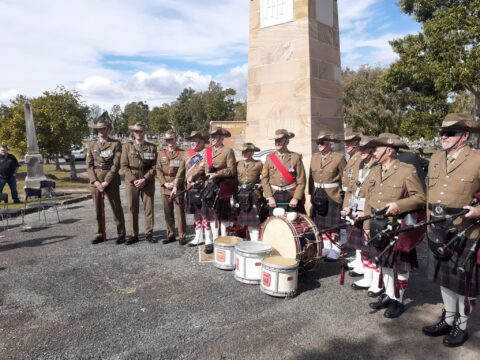
(L to R) 31/42RQR WO1 David Harding (RSM), LtCol David Gandy (CO), Col Arran Hassal (11 Bde Asst Comd), with
The Pipes and Drums of the National Service Association
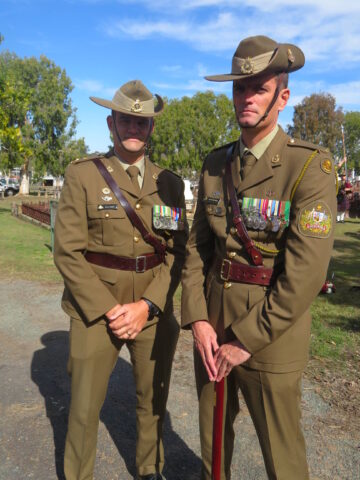
31/42RQR – LTCOLDavid Gandy(C0) with WO1 David Harding (RSM)
–
Address of Commemoration – 2022
LTCOL David Gandy
Ladies and Gentlemen, the Honourable Shayne Neumann MP Federal Member for Blair, the Mayor of Ipswich Teresa Harding, The Deputy President of the Ipswich RSL Mr Paul Rogers, President of Rosewood Mr Bernie Mason, The President of the Moreton District Mr Les Nash. Assistant Commander of the Queensland own 11th Brigade Colonel Arran Hassel, honoured members of the association, fellow veterans, serving members and last but not least the president of the 31st Association- Brisbane branch, Ray Fogg and Tony Wadeson for their excellent work behind the scenes setting up this important yet historic anniversary of one of the darkest days of our military history.
Before I continue – I also want to pay my respect to the traditional owners and inhabitants of this land for which we stand and I also pay my respects to the indigenous elders both past, present and emerging.
To quote Mark Twain, history doesn’t repeat itself, but it often rhymes. Whilst we are here today to honour the ultimate sacrifice made by those 5,533 souls 106 years ago in the dark muddy fields in France far from home… it behoves us all, whether we are military professionals, leaders or politicians to never forget or lose sight of the long term cost and ramifications of the pointless tactical actions and poor strategic decisions. For this very reason the Australian War Memorial was deliberately built and placed within direct view of the decision makers within our parliament as a sobering reminder of the cost of war. The RSM Wo1 Dave Harding and I are both veterans of multiple operational tours and unfortunately we have experienced loss and witnessed one too many ramp ceremonies whereby we bid farewell to our soldiers, subordinates and mates and had to live with those consequences every day. However as Commanding officer and RSM of 31/42 Battalion the Royal Queensland Regiment… we are driven by the sacrifices made by these heroes and patriots and we are 100% motivated to ensure that the men and women who don the uniform and wear the minotaur & whispering boomerang patch serve and parade with their sacrifices in mind… and I am exceptionally honoured to tell you shortly how the Battalion and the Brigade is honouring these sacrifices through the multiple lines of effort they commit to every day in service to this nation.
But first to retrace history – please allow me 5 mins to remind us all of the harrowing tales of this tactical abortion to quote the Divisional commander at the time.
The attack on Fromelles on 19 July 1916 was the first major battle fought by Australian troops on the Western Front. This failed offensive was a feint designed to prevent the Germans reinforcing their troops on the Somme, where the Allies had launched a major offensive on 1 July. The ruse, however as we know was unsuccessful. The 5th Division, that undertook the attack, was a mix of Gallipoli veterans and newly trained reinforcements. At that time the 5th Division comprised of the 8th, 14th and 15th Infantry Brigades each, in turn were made up of four battalions and support troops. The 8th Bde comprised the 29th , 30th , 31st and 32nd Battalions;. The 31st Battalion comprised approximately 1000 men broken up into four companies, with A and B Coy from Queensland and C and D Coy from Victoria.
The location of this diversion was directed towards heavily reinforced defensive fortifications that consisted of strong concrete trenches, overhead protection bristling with barbed wire up on high ground. The Enemy consisted of the 6th Bavarian Reserve Division supported by the two flanking Divisions of the German 6 th Army. In the ranks of the enemies 16th Bavarian Reserve Infantry Regiment at Fromelles was a young despatch runner named Adolf Hitler who, during the battle, faced the direct fire of advancing Australians in the conduct of his duties. Unfortunately not accurate fire.
From the outset the conditions were not set and confusion reigned supreme with little to no confirmation of the enemy’s intent and disposition. Prior to the start of the Fromelles attack 2nd Lieutenant Waldo Zander, a 30th Battalion officer from Sydney, recalled how confused he was by mixed messages given to him and his men. He also noted that despite appeals for secrecy he had heard French citizens in the local towns asking when the big day would be. The battle was never going to be the surprise that the Allies hoped for with cleverly situated German observation points, some camouflaged within trees, observing the troop assembly areas.
Furthermore, the preliminary British bombardment, which commenced on 16 July, which was aimed to decimate the German defensive position had warned the Germans that an attack was likely. As the troops moved into position on 19 July, they were unaware that they were being watched by German observers a mile away. The Germans heavily shelled the assembly area and communications trenches, causing hundreds of Australian and British casualties before the attack even started. It was in one of the early salvos where the ammunition and bomb dump of the 31st Battalion was blown up and many casualties sustained including BHQ and medical staff. Only through the valiant efforts of the Battalions members clearing the burning boxes was half of the ordnance saved. So the warning signs and combat indicators were being ignored or not being acted upon.
In military tactics 101, you need to set the conditions and achieve a series of decisive points before committing to action. Especially if the idea is to deceive the enemy. However in the absence of any situational awareness or understanding of the enemy the order to go ahead was given.
The Fromelles attack began at 6.00pm which provided clear visibility for the defending German troops who were strong, organised, well-disciplined and an experienced unit who controlled the initiative. In their first full- fledged attack on the Western Front the Australians launched themselves into it. At H Hour the first wave of the 31st and 32nd battalions moved bravely over the parapet to commence their assault over open ground covered by the enemies many mutually supporting Machineguns and artillery. The initial response from the Germans was murderous particularly from the flank where the British had not yet commenced their assault requiring the detonation of subterranean mine full of 1200 pounds of explosives to provide some protection for the Australians from the machinegun fire.
As a result, the initial losses were heavy, however, the Battalions continued to
advance and as they did, the enemy resistance appeared less intense. When the
Australians reached the German parapet, they observed the enemy running away over
open terrain to hold ground in the alleys and the dugouts to the rear. Close quarter
combat ensued and the position was held by the Australians who captured 35 prisoners in
the process of clearing the trenches. This action created a foothold for the following waves to better move through “No-man’s land” with the exception of farm on the extreme left flank from which there was no cover. Confusion over objectives saw the 32nd battalion commence an assault on the farm, but with no cover and fierce resistance the attack failed and the Battalion withdrew as the 31st Battalion pushed further ahead. In the fog of war with inaccurate sketch maps, poor communications, no cover, murderous machinegun fire by a strong well positioned enemy and a constant bombardment of indiscriminate friendly and enemy artillery causing enormous casualties… the entire front line was spread thin and disjointed presenting huge gaps in the Australian and British front line.
Failed forays forward was best described as follows by a CPL in the forward edge of the battle.
‘If you had gathered the stock of a thousand butcher-shops, cut it into small pieces and strewn it about, it would give you a faint conception of the shambles those trenches were.”
Desperate attempts were made to regroup, close gaps, establish defensive structures to
provide cover, regain communications and conduct resupply with minimal success whilst
the dead piled higher. As darkness consumed the battlefield, valiant attempts were made to hold ground using all available cover as well as the conduct of spoiling attacks on the enemy. The protracted fighting throughout the day and night saw ammunition and
provisions starting to run low increasing the amount of hand to hand fighting in pockets of
the front line. With limited ammunition to repel constant counter attack, parties now began to return back across no-man’s land in a desperate attempt to find solace from the death and horror of this series of tactical blunders.
All in all – The Germans had survived the British preparatory barrage mostly intact. The same treatment was issued and dealt to the British troops attacking south of the ‘Sugar Loaf’ who were similarly cut down like wheat falling to a harvester.
A second assault co-ordinated by the British to take the ‘Sugar Loaf’ led to another Australian attack being decisively cut down by the Germans. Tragically in this instance even though the British had subsequently cancelled the attack, this information was not communicated to the Australian units in time.
Fromelles is generally considered the worst 24 hours of Australia’s military history, and viscerally described by ‘Pompey Elliott the commander of the 5thDivisions’ 15th Brigade as a ‘tactical abortion’ The Australian toll at Fromelles was equivalent to the total Australian casualties in the Boer War, Korean War and Vietnam War put together. It was a staggering disaster that had no redeeming tactical justification whatsoever.
Now – Due to the high casualties, the Battle was basically kept under wraps and as the Aust. 1st – 2nd & 4th Divisions entered the Battle of the Somme on the 23rd July the Battle of Fromelles was forgotten & the casualties conveniently became part of the Somme offensive. The British never ever recorded Fromelles as a separate Battle & it is not recognised as such to this Day. However, Australians regard it as a Battle & the 31st Bn being the only Unit of the 5th Div in WW1 still operational & on strength in the ADF, I can assure you we will continue to recognise it & commemorate the Diggers who fought & died there as I said earlier. Many soldiers from this battle were and still remain unidentified and buried in mass graves in proximity to where the fighting took place predominantly in no mans lands whereby they were buried in groups of ten. It is largely thanks to the work of Lambis Englezos in finding and identifying Australian soldiers killed in the battle that this number is reducing as we gather here today The story of Lambis is well documented by Tony and I strongly recommend you all read about his mission and quest to date (See Archives June 2021 and July 2021 in this website). Including two 31 st Battalion members LCPL R Johnson and PTE L C Dunn, whose headstones were recently unveiled in 2019 in Fromelles.
Which brings me in conclusion to end on a more positive note and advise you how we are honouring the memories of the fallen. The 31/42 RQR is a proud unit that stretches from Cairns to Biloela and is steadily growing from strength to strength from its humble beginnings to form and constitute the vanguard of the 11th brigade in the north and central Queensland. Given its valued geographical position, it is strongly supported by the 3rd Combat brigade and 5th Aviation Regiment for which we are habitually aligned and this provides the 11th Brigade with a range of excellent training opportunities and access to equipment and platforms that enable the unit to be very effective and capable. Whilst the unit is small, it certainly packs a punch as evidenced by the amount of activities, exercises and deployments the unit has committed to and being relied to complete recently.
Believe it or not, the unit has deployed on every domestic emergency response operation with the exception of three occasions in the last 5 years. Whether it be in support of the residents affected by bushfires in Kangaroo Island and Victoria, floods in SE QLD, Townsville and Mackay, the ongoing support to the pandemic and nursing homes throughout the country or live SEARCH and rescue of missing personnel in outback QLD with the QPS- the Bn has led or had representatives present. During my tenure, the Bn has deployed section strength size elements on 3x 6 month deployments supporting border protection efforts in NW Australia and at the beginning of the year the RSM and I led an OP Resolute rotation out of Torres Straight which is the first time the Bn led an operation in quite some time.
Right now the Bn along with 9 RQR and 25/49 RQR have deployed to Tully conducting Jungle training in the true spiritual home of the infantry. Which is once again the first time a purely reserve contingent has been able to muster a commitment that size. The unit is leading force modernisation efforts as part of the second division road to being an independent and fully capable formation able to lead ADF domestic response effort regardless of the threat, for which the division is and will be able to do. The division is extremely well led by MAJGEN Dave Thomae as is the Brigade under BRIG Mark Armstrong and COL Hassell who I have to give a shout out too as he is standing right in front of me. They have driven this direction and the soldiers are happy and willing to support.
As Fulltime operators, the RSM and I are continually stunned and extremely proud of the ARES soldier who have demonstrated time and time again how capable they truly are. Their commitment to the Army is a true inspiration to us all as it is generally is their third priority behind their civilian employment and their family, yet they turn up and provide a level of service and professionalism that rivals the hardened soldiers in the Combat brigades for which i have served most of my career. These soldiers are your front line, they are very capable, battle hardened, ready, motivated and they will continue to support the respective communities that they are a part of and they are honoured to do so as with every time they don the uniform, the colour patch of the whispering boomerang and the raging minotaur …they are honouring the memory of our fallen who made the ultimate sacrifice. Many have tried to forget about this failed offensive, however I assure you we will continue to punch on.
As per our motto – Semper paratus defendere / cede nullius..
Lest we forget
–
As mentioned above, our 106th Anniversary Commemoration of the Battle of Fromelles (Tuesday 19th July) a student from St Edmunds College gave a short address featuring an ex student of his school, Lt James Danaher who had fought in the Battle of Fromelles with the 31st Battalion.
–
The student had attended last year’s Commemoration, where a student from Ipswich Grammar School gave a short address on one of their ex students, Cpl ER Kent MM, who also fought with the 31st Battalion in the Battle of Fromelles, and is buried only 30 feet from where we held the Commemoration.
–
The St Edmunds student delved into the records of his school and the Army and matched Lt James Danaher with both the 31st Battalion at the Battle of Fromelles and his school.
He is to be commended on his initiative and research skills.
–
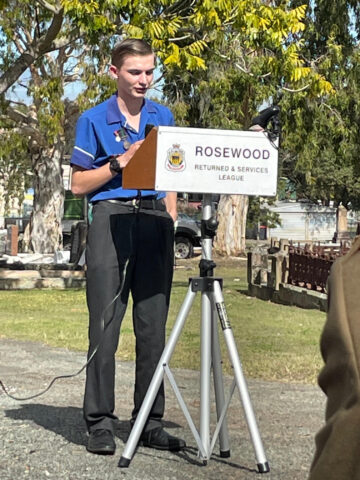
This is his Address-
James Danaher attended Ipswich Christian Brothers’ College now known as St Edmunds College. After graduation, he passed the civil service examination and joined the staff of the Lands Department. Later he qualified as a surveyor, and at the time of his enlistment had his own camp. Aged 26, he enlisted into the Australian Imperial Forces on the 28th of June 1915. He was assigned to the 31st Battalion B company which left Australian shores on the 9th of November 1915.
–
They trained in Egypt around the Suez Canal for 6 months. This also included guarding the Canal from the Turks. During this time James was appointed Lance Cpl. In late June 1916 the Battalion together with the rest of the 5th Division trans shipped to Marseilles and then entrained to the area behind the Front Line in Northern France known as the Nursery Sector.
–
Less than 3 weeks later, James fought in the battle of Fromelles supporting his mates as they find themselves in the darkest 24-hour period in Australian history. James wrote frequently back to his family in Harrisville informing them of his times in France. The following was written after the battle of Fromelles by James to his parents:
“One can form no idea whatever of an attack unless one has leaned right in. It Is Impossible to imagine it, and the greatest war writer could give a non-participant but a faint idea of it. We moved into our supports on Sunday night and remained there till Tuesday morning, then we went to our frontline and remained there till our charge came off on Wednesday evening. As is usual, the infantry attack was preceded by fierce artillery bombardment. It was, of course, replied to by our enemy-Fritz, as he is known. There were high explosives and shrapnel galore, which accounted for a few. As the day went on, the bombardment grew fiercer, until we mounted the parapets to make our dash for the fritz’s trench, everything was just in hell. We had no trouble in taking the first German trench. From here we went on and on we commenced to “dig in.” but being unsupported Fritz counter-attacked and we had to fall back. We held the enemy trench for 10 hours but with no reinforcements being available, we finally went back to our own trench.”
–
James finishes the letter in recognition of his mates whom he fought with:
“The above was a very strenuous few days. Some of our good lads have fallen. They faced it smiling and fell smiling.”
–
His brother, Mr John Danaher, of Toowoomba, received a letter from him, written from France, in which he referred to a trip he had made to Ireland. In the same letter, he also referred to having sent his father a watch, the cover of which had been made from aluminium taken from a Hun aeroplane brought down behind their lines in Fromelles. The letter went on: “Naturally the battlefields abound with trophies of a very interesting nature, but one is too much taken up with a sterner business to bother about them.” He mentioned that he had seen some of their new friends, the Ameri- cans, on the day of writing, and that they were cheerful, energetic, active-looking people. Their way of strolling about was very similar to that of the easy going Australians. He mentioned that he had also seen several Portuguese in the zone, a little behind the line.
–
James always remained positive in all his letters received from family back home.
Six days after the Battle of Fromelles, James was promoted Sgt. He was also selected to attend an Officers Training Course at Trinity College Cambridge in England and left the Battalion in late November 1916. He was promoted to 2nd Lieut on 30 March 1917 and rejoined the 31st Battalion on 11th May after leave and a short stint with the 15th Battalion.
–
James was promoted Lieut (1st) on 11th August 1917 and around that time was appointed Battalion Intelligence Officer (no doubt his skills as a Surveyor assisted him in drawing accurate maps from his Reconnaissance trips).
–
It was during one of these reconnaissance trips during the Battle of Polygon Wood with the Battalion Commander, Lt Col Fred Toll, that James was struck by artillery bombardment shrapnel and killed instantly. As recorded in the Australian Red Cross wounded and missing enquiry it was found that during the bombardment 5 Ipswich soldiers removed their firearms to help bury his body in no man’s land where it remains to this day, but not marked.
–
Today we remember not only James but all the 31st battalion members who fought in Fromelles, from those who returned safely to those who never returned or lay to rest in the fields of Fromelles.
Lest we forget.
–
A remarkable effort by the student and deserving high praise.
Cpl ER Kent MM mentioned previously, was one of the 5 men who buried James during the Battle of Polygon Wood, and the relatives of James visited Cpl Kent’s grave after the Commemoration to pay their respects.
LEST WE FORGET
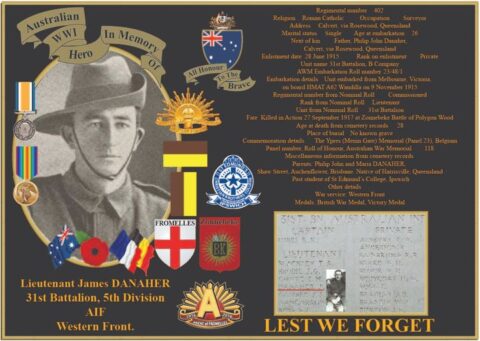
Plaque of Lt James Danaher arranged by our Honorary Member at Fromelles, France
Pierre Seillier
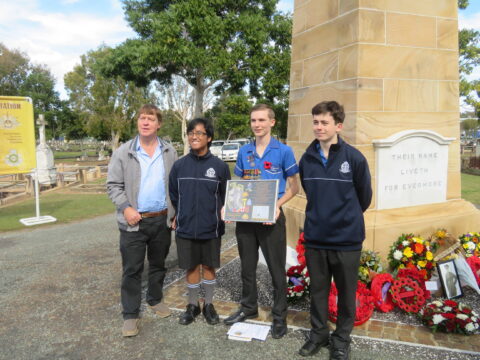
James Danaher III (great Nephew of Lt Danaher), with Students of St Edmund’s College
Student Joel Holding Copy of Plaque Honouring Lt James Danaher
–
GALLERY
